A synergy horn with open mids will not radiate like true dipole. A dipole has same kind of radiation pattern front and back and at (nearly) same level. I think that a horn with open mids could act like supercardioid.
Anyway this backside radiation makes lots of frontwall reflections and boosts power response. How it sounds depends on speaker location, it can be for good or bad!.
Anyway this backside radiation makes lots of frontwall reflections and boosts power response. How it sounds depends on speaker location, it can be for good or bad!.
Yeah I think that's probably the wisest route.
The LeCleach has some decent looking impulse response, but the polars are dreadful. This is mostly due to my crummy horn construction, and the fact that the midranges holes are 'tapped in' at a section of the horn where the area isn't very high at all.
Right now what I'm trying to figure out what type of directivity I want.
I used open back midranges on this Synergy horn mostly because I wanted to minimize the 'giant headphones' effect.
But it's not as simple as running them dipole; I also have to consider that dipole radiation requires different crossover points and requires different EQ than monopole does.
So before making any sawdust, I need to figure that out.
Tonight I ran some sims on various combinations of crossover point and woofers.
Basically trying to figure out if I should use one woofer or two, and what the crossover point should be.
Here's some examples:

^^ Here's a sim with one waveguide, one woofer, first order xover, and a xover frequency of 1120hz
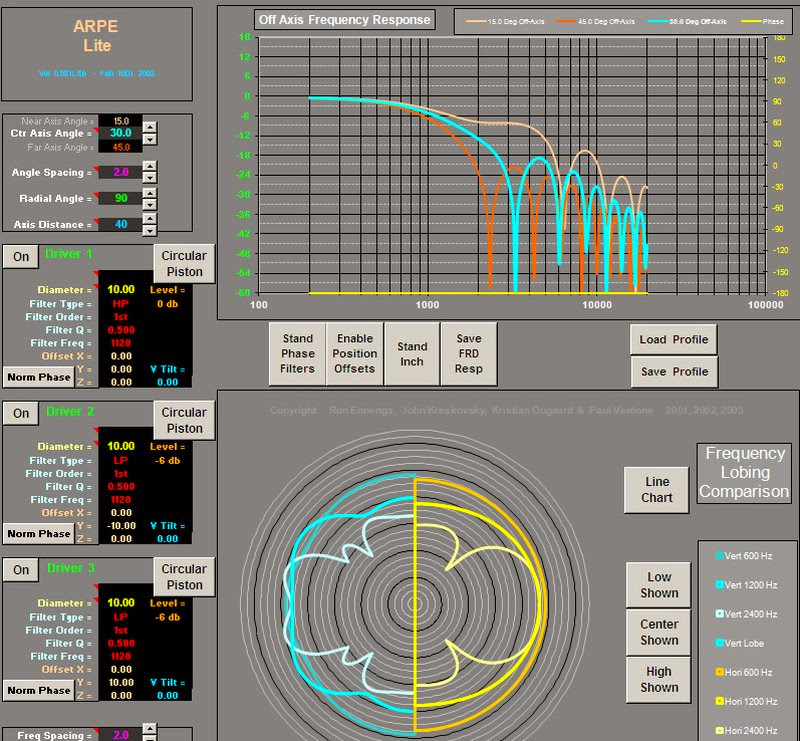
^^ Here's a sim with one waveguide, two woofers, first order xover, and a xover frequency of 1120hz
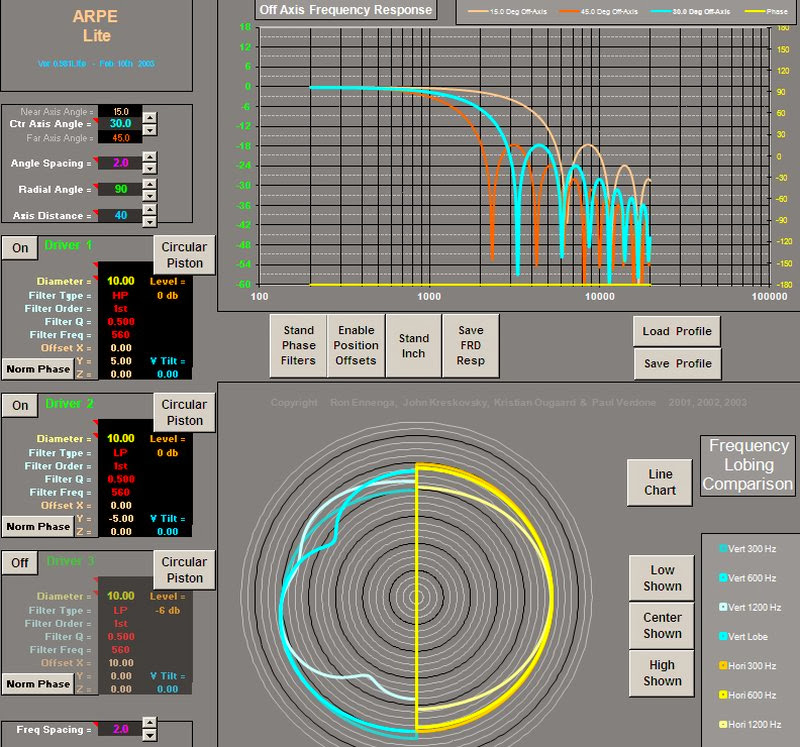
^^ Here's a sim with one waveguide, one woofer, first order xover, and a xover frequency of 560hz
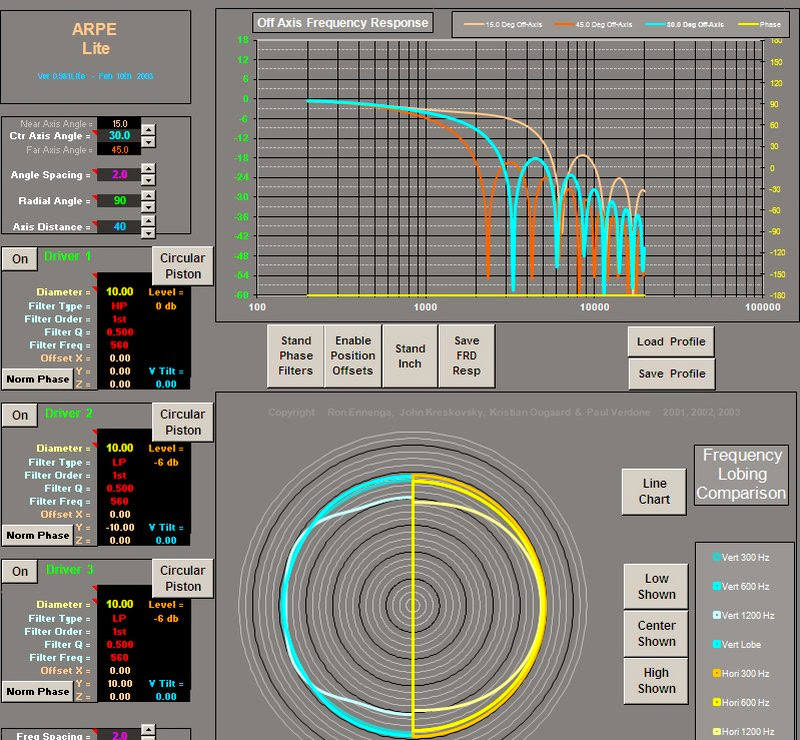
^^ Here's a sim with one waveguide, two woofers, first order xover, and a xover frequency of 560hz
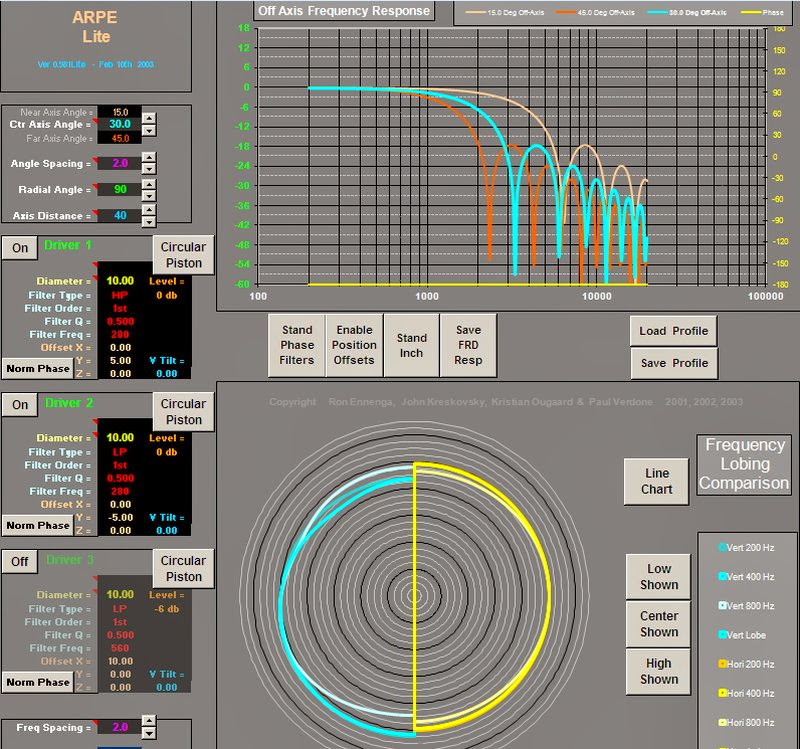
^^ Here's a sim with one waveguide, one woofer, first order xover, and a xover frequency of 280hz
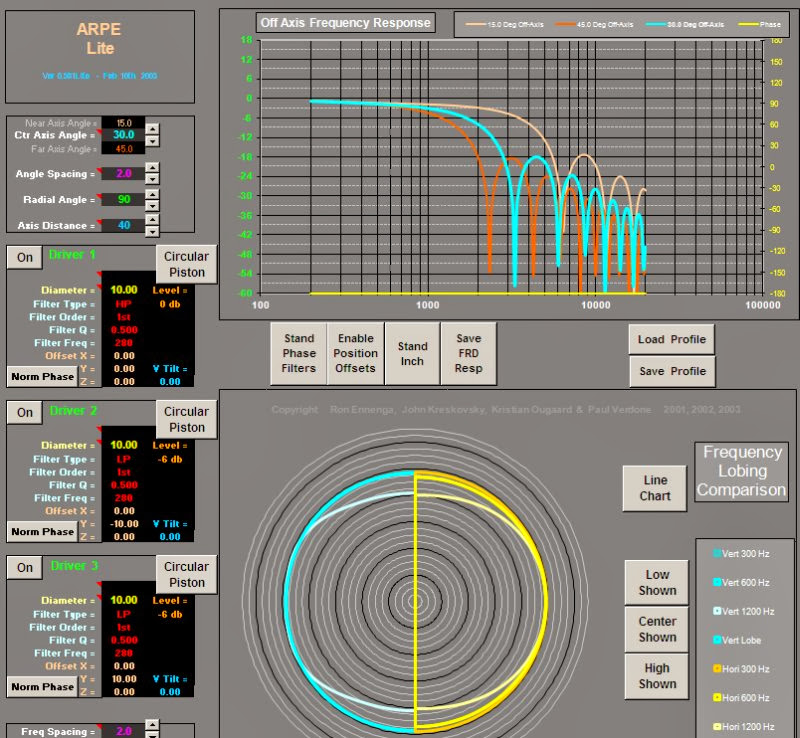
^^ Here's a sim with one waveguide, one woofer, first order xover, and a xover frequency of 280hz
Some observations:
1) All of the horizontal polars basically look the same, because going from one woofer to two doesn't impact the horizontal response much. Most of the change is seen in the vertical polars.
2) A crossover point of 1120hz sounds a little high for a Synergy horn. But due to the low order slopes, the woofers on the Synergy horn are only down 15dB at 280hz with a 1st order xover at 1120hz.
3) The polars of the 280hz xover look the best, but I'm not sure if the Dayton mids can handle that. With a 280hz 1st order xover the Daytons will only be 15dB down at 70hz and 21dB down at 35hz. Not sure if they can do that. If I *do* go that route, some serious EQ will be required.
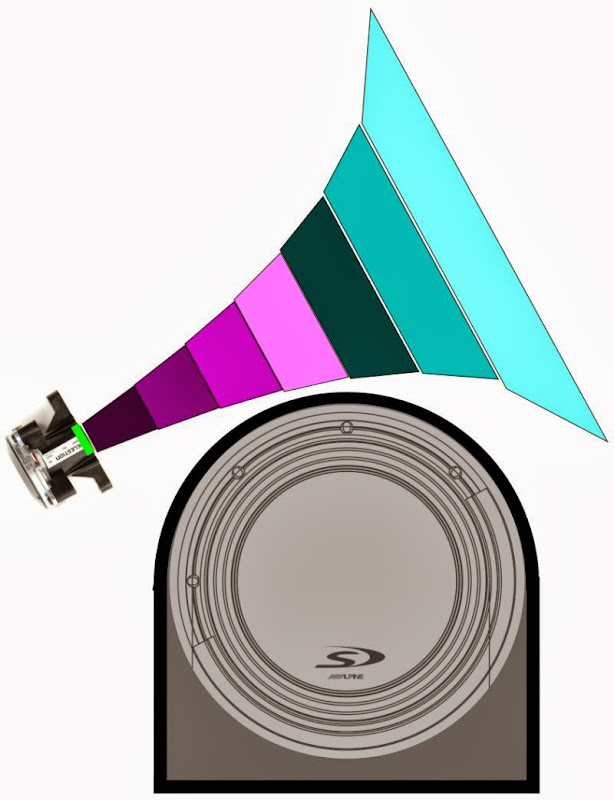
Here's the old design for Monster Massive. I've moved away from these plans for the following reasons:
1) LeCleach sounds really nice, but there is a massive dip in the response due to reflections off the midrange taps. I think that the confined space at the throat exacerbates this. If you look at a Danley Synergy horn, you'll notice that the first few inches expands much faster, due to the walls having flat sides. So there's simply more area by the time we reach the midrange taps, and I think that reduces the effect of the taps.
2) With the LeCleach the frequencies below 1khz sounded a bit 'off' and I think this is due to the quickly broadening directivity. Above 1khz it sounded great, but I think if you want to run a LeCleach down to 250hz you'll need a bigger horn. (IE, the flare rate may be 250hz, but the directivity of my horn was only good to about 1khz. So there's a two octave range where the directivity is basically omnipolar.)

Here's the new design. It features:
1) A two way synergy horn on top, using the QSC waveguide sold by Parts Express, which measures 36cm x 25cm. That should give me directivity control down to about 1100hz.
2) The woofer below the QSC waveguide is a TC Sounds 15. I'm going to run this as a dipole.
3) The midranges will be four Dayton ND91s.
I'm hoping for crossover points like this:
tweeter : 1200hz - 20khz (4 octaves)
midrange : 300hz - 1200hz (2 octaves)
woofers : 100hz - 300hz (1.5 octaves)
I'm not 100% sure on what the slopes yet.
First order slopes have the least phase distortion.
Having said that, I've read that there's a way to do 2nd order crossovers and keep everything in phase by putting a narrow bandwidth midrange between the tweeter and the woofer.
Can't find the article ATM, but John Kreskovsky from musicanddesign.com wrote an article on something like this for Speaker Builder about a decade ago.
An externally hosted image should be here but it was not working when we last tested it.
An externally hosted image should be here but it was not working when we last tested it.
Monster Massive I was inspired by the Jadis Eurythmie; Monster Massive II was inspired by the Gradient Helsinki. I basically showed my girlfriend and her daughter as series of loudspeakers and asked them which one they could live with.
.... a narrow bandwidth midrange between the tweeter and the woofer.[/b]
Can't find the article ATM, but John Kreskovsky from musicanddesign.com wrote an article on something like this for Speaker Builder about a decade ago.
cue-word ... B&O filler driver
Duelund and Beyond
is that the article ?
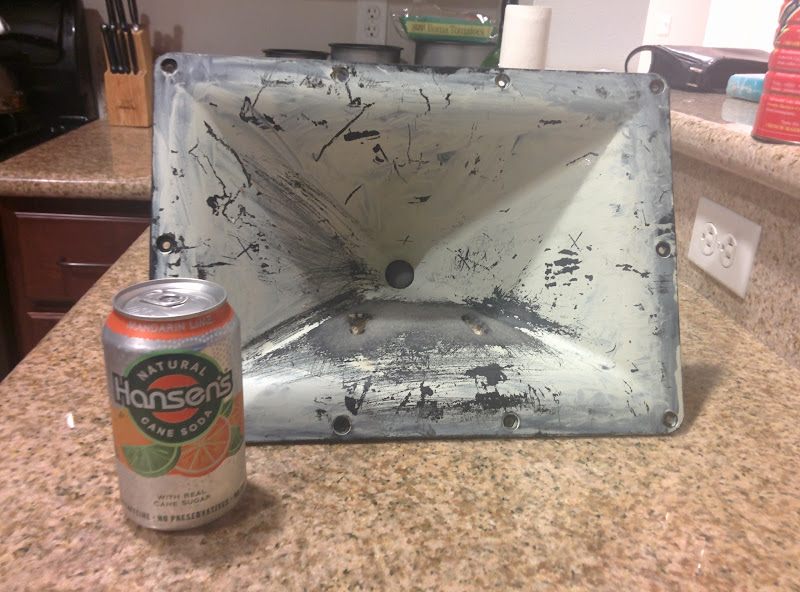

Here's some pics of the horn coming together.
Waveguide is the ubiquitous QSC PL-000446GP.
Tweeter is the Celestion CDX1-1425. (Mine are rebadged by QSC.)
Midrange is the ND91.
Woofer will likely be a TC Sounds 15.
An externally hosted image should be here but it was not working when we last tested it.
Midrange ports are long and skinny, similar to some of the Yorkville and Danley Synergy horns.
Patrick,1) LeCleach sounds really nice, but there is a massive dip in the response due to reflections off the midrange taps. I think that the confined space at the throat exacerbates this.
Here's the new design. It features:
I'm hoping for crossover points like this:
tweeter : 1200hz - 20khz (4 octaves)
midrange : 300hz - 1200hz (2 octaves)
woofers : 100hz - 300hz (1.5 octaves)
I'm not 100% sure on what the slopes yet.
First order slopes have the least phase distortion.
1) Did you ever try shorting the midrange drivers out when testing the HF to see if they were acting as a resonant trap, rather than the tap hole reflections being the cause of the massive midrange dip?
2) The acoustical crossover slope will never be "first order" in a Synergy design regardless of the electrical filters used.
What do you mean by "phase distortion"?
Art
Patrick,
1) Did you ever try shorting the midrange drivers out when testing the HF to see if they were acting as a resonant trap, rather than the tap hole reflections being the cause of the massive midrange dip?
2) The acoustical crossover slope will never be "first order" in a Synergy design regardless of the electrical filters used.
What do you mean by "phase distortion"?
Art
While the dip at 1200hz was a bummer, there was a bigger problem with my LeCleach horn.
Here's what I think is going on:
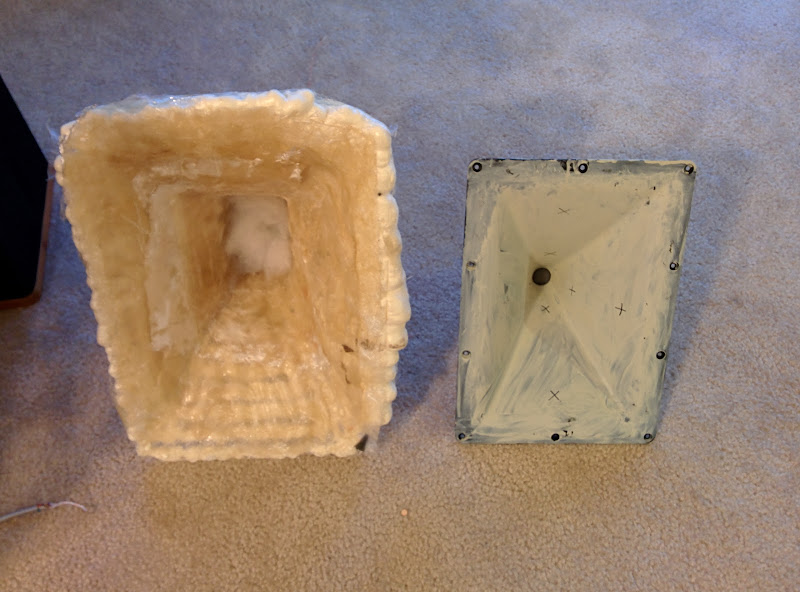
On the left is my LeCleach horn, with a mouth that follows the golden ratio. Cutoff is something like 350hz
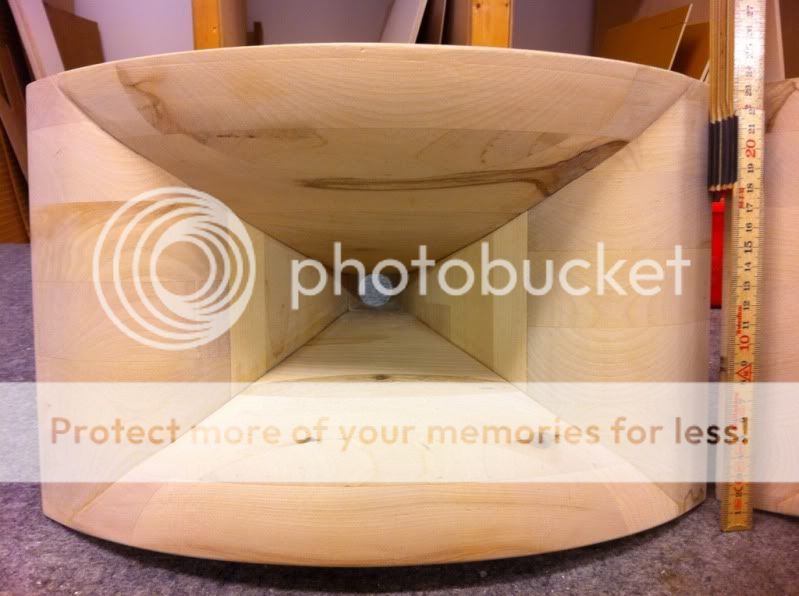
Here's a similar horn made by someone in Sweden named 'Asto' in wood. (From http://www.diyaudio.com/forums/multi-way/227939-astos-biradial-lecleach-wooden-horns.html )

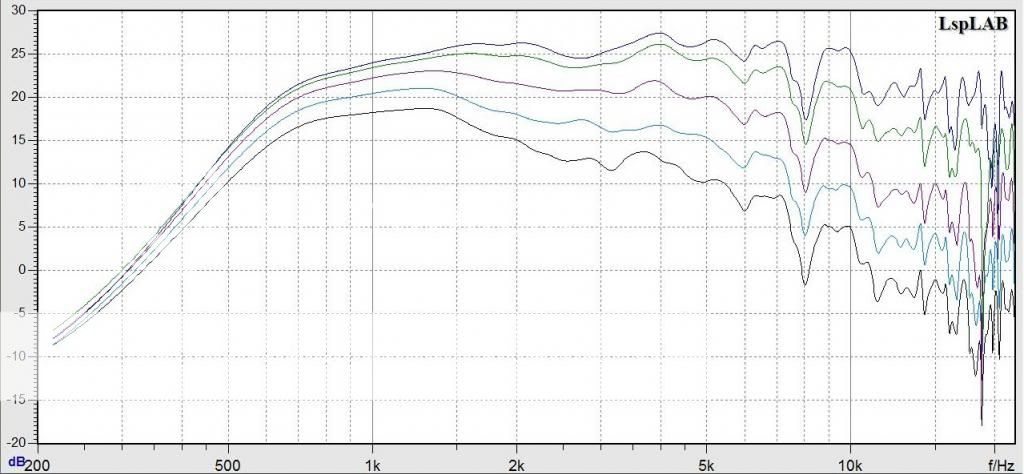
Here's the polar response of our two horns. See how my horn isn't very consistent, and my horn is rolling off the highs?
I think a great deal of this is due to my crummy craftsmanship. The rough and inconsistent shape and surface of the horn is hurting the consistency of the polar response and it's rolling off the highs. At 10khz my horn has lost 10dB of output, Asto's has lost none. (Ignore the green curve, that's the QSC waveguide which I was comparing the LeCleach to.)
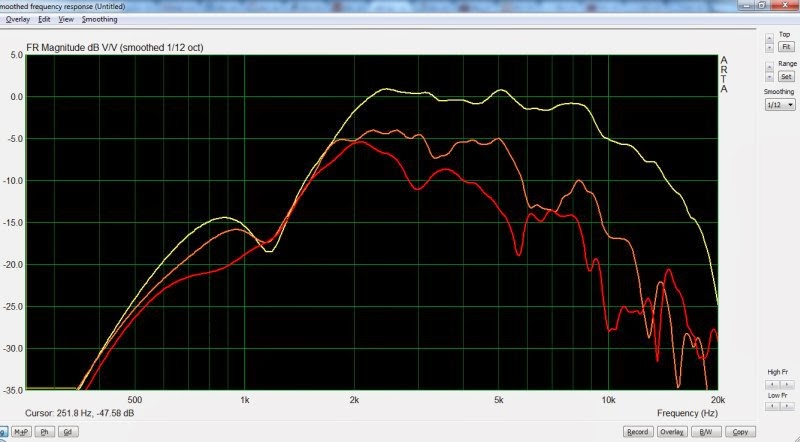
Here's the response with the crossover; basically I'm TRYING to flatten it out electrically, but failing, because the problem isn't electrical it's physical

Here's the QSC with crossover, which is much more consistent
Bottom line - my fiberglass LeCleach horn is pretty hopeless. There's a reason that people pay $500 a pair for horns from Autotech
I'll admit that the dip in the midrange from the taps is probably not the end of the world, but that polar response is un-fixable
Last edited:
Patrick,While the dip at 1200hz was a bummer, there was a bigger problem with my LeCleach horn.
See how my horn isn't very consistent, and my horn is rolling off the highs?
I think a great deal of this is due to my crummy craftsmanship.
Bottom line - my fiberglass LeCleach horn is pretty hopeless.
I'll admit that the dip in the midrange from the taps is probably not the end of the world, but that polar response is un-fixable
I agree that your LeCleachoid horn is hopeless, but you still did not answer the question, did you ever try shorting the midrange drivers out when testing the HF to see if they were acting as a resonant trap, rather than the tap hole reflections being the cause of the massive 1200 Hz dip?
Maybe after three tries you'll answer
Art
Patrick,
I agree that your LeCleachoid horn is hopeless, but you still did not answer the question, did you ever try shorting the midrange drivers out when testing the HF to see if they were acting as a resonant trap, rather than the tap hole reflections being the cause of the massive 1200 Hz dip?
Maybe after three tries you'll answer...
Art
Nope, trashed the horn and got to work on a new one.
OK, but remember to short out the unused drivers in the future before testing or trashing them.Nope, trashed the horn and got to work on a new one.
You missed a valuable data point that could have informed you on the nature of the throat port interactions.
How about the other unanswered question:
What do you mean by "phase distortion"?
OK, but remember to short out the unused drivers in the future before testing or trashing them.
You missed a valuable data point that could have informed you on the nature of the throat port interactions.
How about the other unanswered question:
What do you mean by "phase distortion"?
I would prefer to use first order filters.
Tom Danley sent me an email once with some instructions on how to make the drivers in-phase at the crossover, but his email went right over my head.
Although I would prefer to keep the tweeter and the midrange in phase, I concede that phase is a complex subject that I do not understand very well, and that the phase of the midrange and tweeters is complicated by the horn and the coupling chambers. (IE, it's not as simple as 'just use first order filters.')
I just re-read Tom's email, and without disclosing the content of the email, it's safe to say that it's not as simple as picking the right filter shape. (IE, a simple first order won't do it.)
You have to juggle a bunch of parameters:
1) location of the taps
2) crossover point of midrange
3) crossover point of tweeter
4) slope of midrange
5) slope of tweeter
To make all of this more maddening, I don't even know how to do a decent phase measurement. Looked into buying a TEF at one point, but that's probably putting the cart before the horse.
You have to juggle a bunch of parameters:
1) location of the taps
2) crossover point of midrange
3) crossover point of tweeter
4) slope of midrange
5) slope of tweeter
To make all of this more maddening, I don't even know how to do a decent phase measurement. Looked into buying a TEF at one point, but that's probably putting the cart before the horse.
Again, no answer to the question, what do you mean by "phase distortion".I would prefer to use first order filters.
Tom Danley sent me an email once with some instructions on how to make the drivers in-phase at the crossover, but his email went right over my head.
Although I would prefer to keep the tweeter and the midrange in phase, I concede that phase is a complex subject that I do not understand very well, and that the phase of the midrange and tweeters is complicated by the horn and the coupling chambers. (IE, it's not as simple as 'just use first order filters.')
And no explanation of why you would prefer first order filters when there are no DSL Synergy horns that do.
Assuming you mean "phase distortion" to be a rapid change in phase between drivers around the acoustic crossover point, using a single capacitor or coil (first order) as a crossover with a Synergy horn is often a good way to introduce the very thing you want to avoid.
The goal in any crossover design should be a smooth frequency and phase transition at the acoustic crossover point.
To achieve those goals in a Synergy design one can't use the same crossover topology one would use in a front loaded system.
You now have a horn that may work, if the crossover (and driver spacing) is implemented correctly.
If your measurement system can't measure phase, you will have a way tougher time getting the crossover right, especially considering you are planning a three way, which is way tougher than a two-way.
And if you are not using DSP, you are going to need dozens of different value capacitors, coils and resistors to experiment with to "get it right".
Have fun!
Art
Last edited:
Again, no answer to the question, what do you mean by "phase distortion".
I want the midrange and the tweeter to have a phase curve that looks like a single driver. I do not want the phase shift that's inherent in a two-way loudspeaker where the two drivers are more than 1/4wl apart and their filters create a phase shift at the xover point and below it.
And no explanation of why you would prefer first order filters when there are no DSL Synergy horns that do.
Assuming you mean "phase distortion" to be a rapid change in phase between drivers around the acoustic crossover point, using a single capacitor or coil (first order) as a crossover with a Synergy horn is often a good way to introduce the very thing you want to avoid.
The goal in any crossover design should be a smooth frequency and phase transition at the acoustic crossover point.
To achieve those goals in a Synergy design one can't use the same crossover topology one would use in a front loaded system.
Time for you to re-read Tom Danley's email, since you now have a horn that may work, if the crossover (and driver spacing) is implemented correctly.
If your measurement system can't measure phase, you will have a way tougher time getting the crossover right, especially considering you are planning a three way, which is way tougher than a two-way.
And if you are not using DSP, you are going to need dozens of different value capacitors, coils and resistors to experiment with to "get it right".
Have fun!
Art
I have two miniDSPs here, and may use them.
I believe Arta can measure phase, but first I need to learn how to do it properly and I need to figure out a way to do measurements outside. (I have no yard, I live in an apartment, my measurements are normally done in the living room with a short gate.)
As noted in my post from a few minutes ago, I'm aware that getting the phase right isn't as simple as using first order filters, because the phase and impedance of a horn loaded driver is more complex than the same driver on a baffle.
You should be able to get decent phase measurements with ARTA, don't get mad, read the manualTo make all of this more maddening, I don't even know how to do a decent phase measurement.
1) Good goal, if the single driver has a flat phase response1)I want the midrange and the tweeter to have a phase curve that looks like a single driver.
2)I do not want the phase shift that's inherent in a two-way loudspeaker where the two drivers are more than 1/4wl apart and their filters create a phase shift at the xover point and below it.
3)I have two miniDSPs here, and may use them.
4)I need to figure out a way to do measurements outside.
5)As noted in my post from a few minutes ago, I'm aware that getting the phase right isn't as simple as using first order filters, because the phase and impedance of a horn loaded driver is more complex than the same driver on a baffle.
2) Drivers on a two way speaker can be more than 1/4 wavelength apart and still have flat on axis phase response throughout the crossover.
3) DSP beats a box load of parts and clip leads by a mile, and you can fix time problems too. Using FIR filters you can even flatten the phase response over the full range of the system.
4) You could put your horn in a window and use a weighted pipe for a mic stand extending a couple meters from the "ground plane".
That said, near field measurements indoors would be OK for "roughing in" all your DSP settings.
5) The phase response of horn loaded drivers is no more complex than front loaded drivers, but may be different.
Using DSP, the impedance can be ignored, other than assuming at some point it will be near DCR.
The impedance interactions between passive components make a passive Synergy crossover devilishly difficult, one can make a crossover that makes the speakers measure flat in frequency and phase, but drops too low in impedance for an amp to handle comfortably. Those problems can be really aggravating, as they only show up with certain source frequencies over a specific amplitude, and may not show up at all on one type of amp, but do on others.

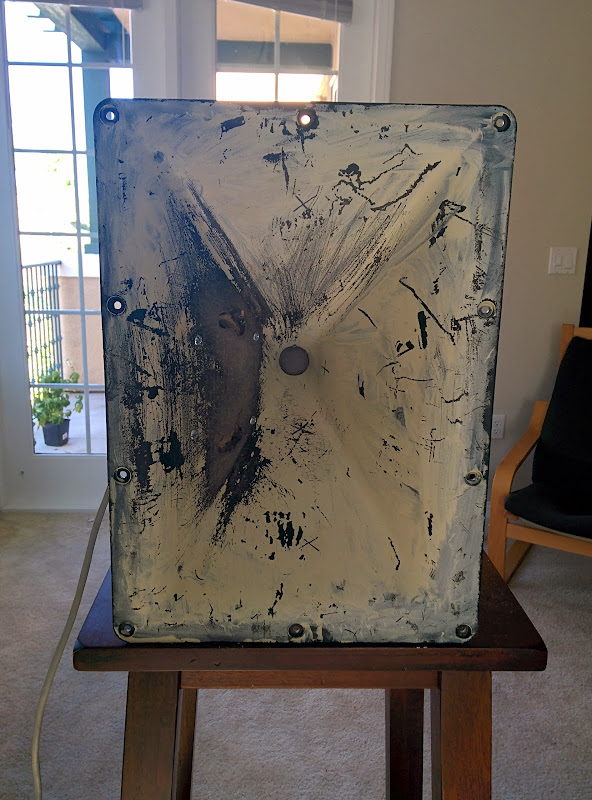

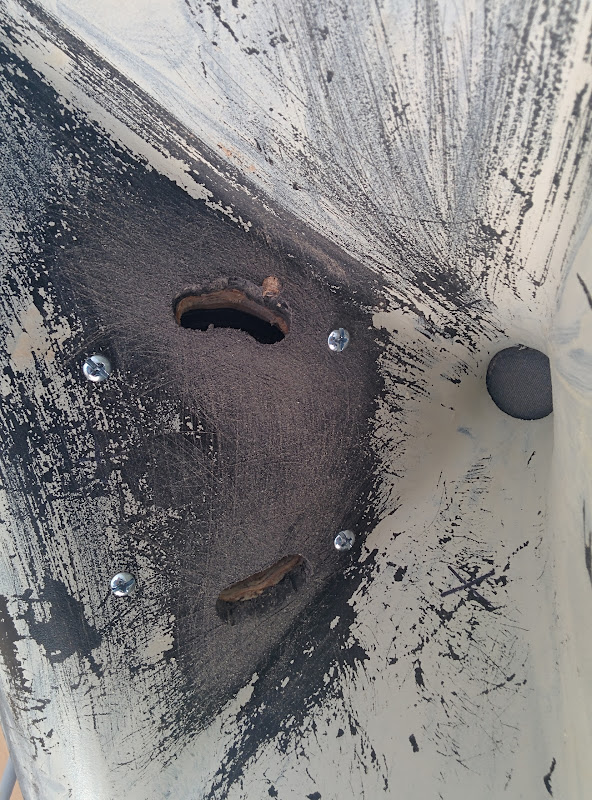
Here's some pics of the latest evolution of this project.
As noted in earlier posts, the horn that I built myself, a LeCleach, didn't measure so hot.
So I rebuilt the horn using the same parts but with a QSC horn, the one from the HPR 152i that's sold by Parts Express for $35
- Status
- This old topic is closed. If you want to reopen this topic, contact a moderator using the "Report Post" button.
- Home
- Loudspeakers
- Multi-Way
- Monster Massive